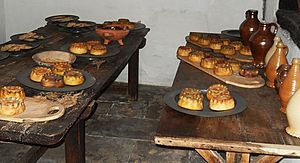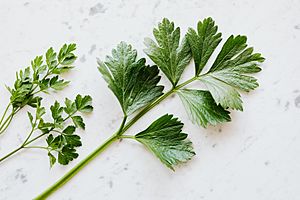Tudor food and drink facts for kids
Tudor food is what people ate and drank in England during the Tudor period, which was from 1485 to 1603. Imagine a time when bread was a super important food, often made from a mix of rye and wheat! People usually ate meat from Sunday to Thursday. On Fridays, Saturdays, and during Lent, they ate fish instead.
Exciting new foods started arriving from the Americas, like tomatoes and potatoes. Rich families loved to throw big parties called banquets with lots of different dishes. For drinks, everyone had ale, and the wealthy also enjoyed wine.
Contents
What Did Tudors Eat?
Vegetables and Herbs
Common vegetables in Tudor times included onions and cabbages. Later in the period, new and exciting foods like tomatoes, potatoes, and carrots arrived from the Americas.
Wealthy Tudors loved to use fresh herbs to make their food taste amazing. They even grew their own herbs in special gardens. Some popular herbs were parsley, mint, rosemary, thyme, and sage.
Fruits
Fruits were also a part of Tudor meals. They were used in cooking or eaten on their own. Some fruits people enjoyed were apples, gooseberries, grapes, oranges, and plums. Back then, some people thought eating too much raw fruit wasn't good for you!
Bread: A Daily Must
Everyone in Tudor times ate bread with almost every meal. It was their main source of energy! But not all bread was the same. The type of bread you ate often showed how rich or poor you were.
The cheapest bread was called Carter's bread. It was a mix of rye and wheat. Middle-class people ate ravel, also known as yeoman's bread, which was made from wholemeal flour. The fanciest and most expensive bread was manchet, made from fine white wheat flour.
Meat and Fish for Everyone
What people ate for meat and fish also depended on their social class. Ordinary people often caught fish from rivers and the sea, like haddock and sole. They also ate meats like rabbits, blackbirds, pheasants, partridges, hens, ducks, and pigeons.
Rich people had a much wider choice. Their fish dishes included sturgeon, seal, crab, lobster, and shrimp. For meat, they enjoyed costly options like swan, peafowl, geese, boar, and deer (venison).
Banquets and Feasts

Wealthy families, known as aristocrats, held huge banquets and feasts. These events had many different courses, and each course had a variety of dishes brought out all at once. Guests could then pick and choose what they wanted to eat.
Meat and Poultry Dishes
- beef
- mutton
- veal
- lamb
- heron
- pigeon
- chicken
- venison pasty and haunch
- pheasant
- partridge
- quail
- sparrow
- goose
Fish Dishes
- lamprey
- haddock
- pike
- salmon
- chub
- sturgeon
- trout
- perch
- crayfish
- bass
- crab
- lobster
- shrimp
- herring
Sweet Dishes
- tarts
- doucets (sweet flans)
- fritters
- eggs
- custards
- jelly
- cream of almonds
- fruit, baked and unbaked
Drinks in Tudor Times
Everyone drank ale during the Tudor period. People thought water was unhealthy back then. Tudor ale was made without hops, which are common in beer today.
Rich people also drank wine. Most of their wine came from other countries in Europe. Some wine was made in vineyards in Southern England, but not much. In the early 1500s, wine was quite expensive for most ordinary people. So, in 1536, a law was made to set a maximum price for wine, especially for those imported from France, Greece, and Spain.
The wealthy drank from fancy wine glasses that were brought from Italy. These were very expensive! Poorer people drank from simple wooden goblets and cups.
Eating Out
By the time William Shakespeare was writing his famous plays, eating out had become quite common. Before the 1400s, there weren't really any public restaurants in London. Instead, there were "cookshops." These were like the fast-food places of their time. You could buy a meal to eat right away, like a hamburger and fries today. But there were no seats or tables; you just grabbed your food and went.
By the 1370s, some outdoor cafes appeared in the areas around Westminster. But proper eating-houses didn't exist yet. Inns and taverns were the first places to act like restaurants. They already had rooms with tables and chairs for guests to dine. We know this started happening around the 1420s. Dedicated eating-houses began to appear around the 1550s.
Table Manners
Having clean hands was super important at the Tudor dinner table. Many people would share food from a common dish, using their fingers. So, they were told to wash their hands where everyone could see, to prove they were clean.
Manners guides from the Renaissance and Middle Ages also listed things you should NOT do at the dinner table. These included:
- Putting fingers in your ears.
- Putting hands on your head.
- Blowing your nose with your hands.
- Men were told not to scratch themselves.
- Blowing your nose or wiping sweat with a napkin.
- Poking around on your plate, maybe looking for a better piece of food.
- Throwing bones on the floor. Bones were supposed to go on a special platter.
- Passing gas.



